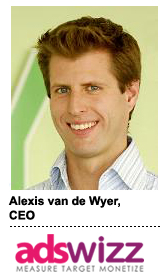 Compared to other digital audio content, podcast advertising has unique measurement challenges. But the medium is growing quickly.
Compared to other digital audio content, podcast advertising has unique measurement challenges. But the medium is growing quickly.
Edison Research claims nearly 46 million Americans, or 15-17% of the US population, listen to a podcast every month. It’s roughly double the size of podcast listeners in 2008.
AdsWizz, which provides radio listening metrics for broadcasters and streaming content measurement tools for online audio platforms, hopes to take advantage of this growth.
“Sometimes there are negative connotations associated with podcasting,” said CEO Alexis van de Wyer. “We look at podcasts as radio on demand. It’s basically listening to the content you’re interested in at the time you’re interested in it, whether that’s podcasts from public radio or independent shows.”
With offices in the United States and Europe, AdsWizz works with ad networks, publishers, digital audio platforms, agencies and advertisers, and clients include Arbitron, Absolute Radio and Triton Digital. It also works with broadcast giants like iHeartMedia, digital radio ad firms like Audioemotion and radio ad networks like RMS.
The firm recently expanded its AudioMetrix offering – designed to tell publishers how many people have downloaded audio content – to accommodate podcasts.
Van de Wyer spoke to AdExchanger.
AdExchanger: What has to happen before programmatic podcasting is a reality?
ALEXIS VAN DE WYER: Since we’re doing dynamic ad insertion into podcasts, we have the insertion piece covered, and the DSPs are also connected to it.
The issue is on the advertisers’ side. It’s going to take a lot of evangelization to show them that podcasting is not something they should be worried about. Right now, they’re concerned that people might not listen through to an ad.
It’s a medium that a lot of audiences listen to right away, so advertisers shouldn’t consider it to be risky or uncertain. You can measure audiences and have third-party tagging attached to podcasts. For people who listen later, advertisers need additional metrics. But buying programmatically, you can do that now.
Does “dynamic ad insertion” mean at the time of download or in real time?
It means at the time of download. When a user downloads a podcast, whether they listen to it immediately or later, ads will be inserted into the beginning and middle of the podcast based on that listener’s behavioral, geographic or other data.
What challenges are your clients facing?
In the past it was the lack of scale. We’ve seen the medium advance fast in the past few months. The next challenge is to quickly get programmatic to scale and to an efficiency that’s comparable to other media.
Also, there’s a challenge to prove the value of digital audio compared to other media. There aren’t enough studies that prove the ROI of audio campaigns versus other media. Some of those stats exist, but the word is not out there enough.
The coming months will be all about demonstrating the power of digital audio. Digital audio has the reach and frequency of radio, but with greater accountability and ROI, and the ability to link the impression to the purchase.
What can publishers do to prove the value of digital audio?
It’s already underway. We work with some of the largest publishers to evangelize and to ensure the value of digital audio. iHeartMedia, for one, is investing a lot in ensuring the value of ad performance for digital audio. We also work with agencies, because agencies are already convinced on digital audio and they want to show that to their advertisers. The coming moths are about presenting one unified story to the advertising world, so that it becomes easier to buy audio.
How can digital audio help advertisers tackle cross device challenges?
When you look at mobile, it’s one of the biggest markets for advertising today, and the number one usage of mobile devices in terms of time consumed is audio. The fact that audio is not used more as a way to monetize mobile is very surprising, and I think that’s going to change.
When people use mobile devices, they’re often not looking at the screen. That’s where audio will prove to be pretty powerful. It’s not a solution for everything, but there’s a significant portion of mobile consumption that is more addressable through audio than through display or video.
What’s next for digital audio?
There is a reason why, in the last six months, digital audio had been embraced more – it adds up to scale for both the advertiser and the publisher to the point where they need to get involved.
Moving forward, it’s mostly a question of awareness. Audio is not yet top of mind. We’re starting to hear more people starting to say it’s an important medium, but it’s really not on the agenda. Audio needs to be part of the conversation. The other thing is simply to make it programmatically available at a larger scale. We’ve partnered with some trade desks and buyers, but it’s still a small number.













